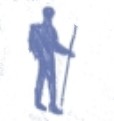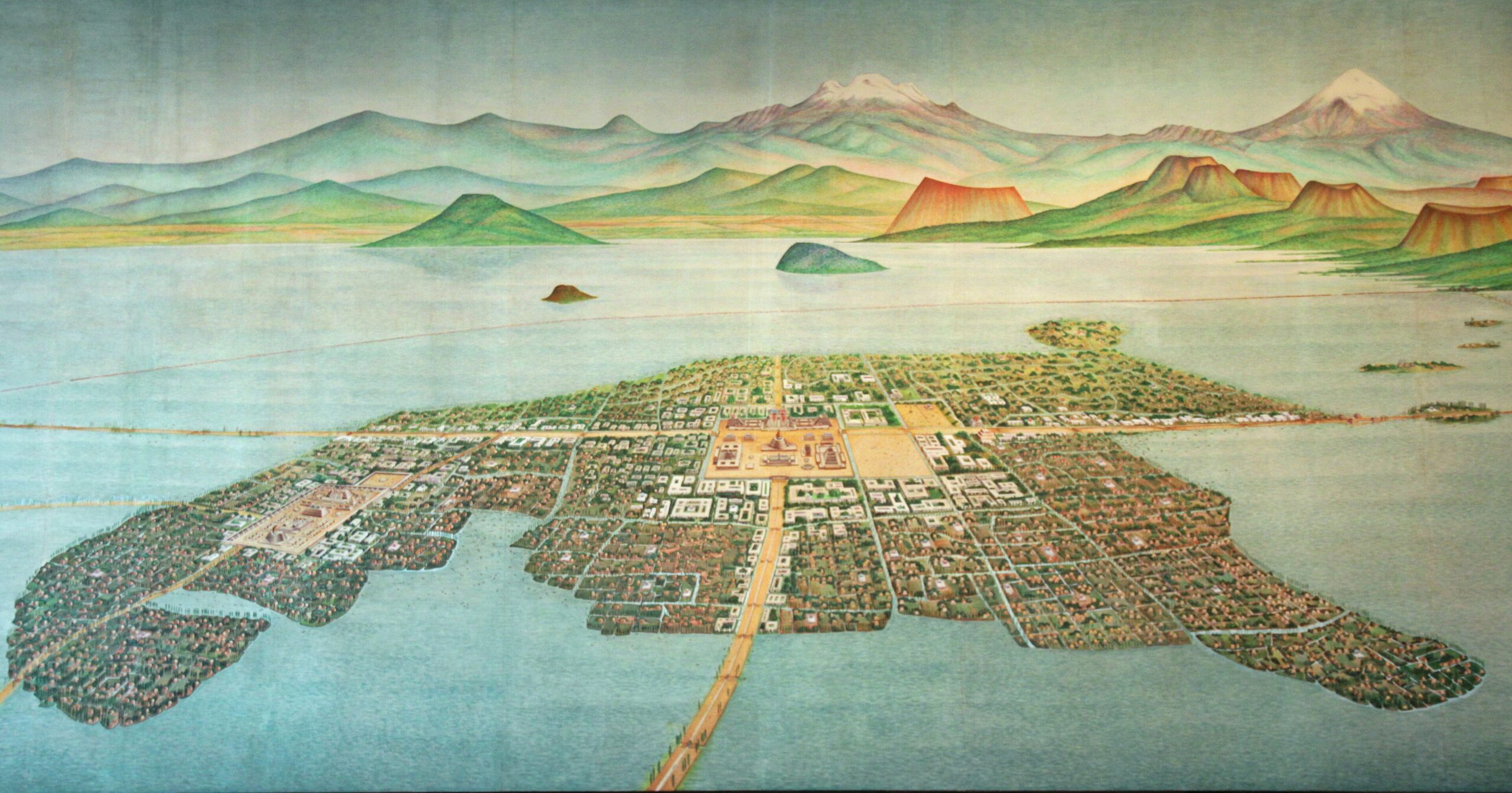Published in Dark Mountain
July 2023
When the Spanish conquistadors first laid eyes on Tenochtitlán, the great capital of the Aztecs, situated on a lake surrounded by snow-capped volcanos, it would have been the largest city that they had ever seen. With its 200,000 inhabitants (Madrid, by contrast, had fewer than 20,000), its marketplaces and broad canals, its monumental pyramids, and its chinampas or floating gardens, it was the cosmopolitan centre of another world. One chronicler, Bernal Díaz del Castillo, recalled later:
These great towns and shrines and buildings rising from the water, all made of stone, seemed like an enchanted vision from the tale of Amadis. Indeed some of our soldiers asked whether it was not all a dream … It was all so wonderful that I do not know how to describe this first glimpse of things never heard of, seen or dreamed of before.
Two years later that city lay in ruins. Its people had been butchered, its shrines destroyed, and its great stepped temples demolished to provide stone for the cathedral of the future Mexico City. The lake that surrounded the island city was drained for agricultural land, and the complex culture of the Aztecs – with its poetry, its astronomy, its written language of glyphs, its teeming pantheon of gods, its arts and its cosmology – was annihilated. Those who survived the initial slaughter, and the waves of disease that followed it, were enslaved and dispossessed. The ‘enchanted vision’ of Bernal Díaz faded like a dream.
Red Smoking Mirror, my debut novel, is an attempt to reimagine that dream. Perhaps because it was so comprehensively destroyed in historical fact, I found myself recasting Tenochtitlán in a different version of reality: the novel is an alternate history in which Moorish Spain, or al-Andalus, was never reconquered by the Christians, and Spain as we know it today never came into existence. In this counterfactual, the first ships to cross the Atlantic in 1492 are crewed not by Spaniards but by Moors, who call the continent they discover the New Maghreb, ‘New West’. They come, at least initially, for trade rather than conquest. Set over the course of several weeks in 1521, the novel centres around the love between the Jewish merchant Eli Ben Abram and his Nahua wife Malinala – based upon the fascinating real-life figure of La Malinche, also known as Malintzín, Marina or La Llorona, the Weeping Woman – as they maintain the delicate balance between several different cultures in the Moorish Quarter of Moctezuma’s glittering capital.

Alternate history sits on a spectrum with science fiction, speculative fiction, historical fiction and fantasy – literary forms all too often scorned by ‘serious’ novelists (with the possible exception of speculative fiction, which is really just a more respectable term for sci-fi). Of all these, alternate history is the least well regarded. There are no Alternate History sections in bookshops; it is usually lumped in with sci-fi, even though one genre, broadly speaking, deals with the future and one with the past.
Perhaps the best-known novel of its kind is Philip K. Dick’s The Man in the High Castle, which imagines the aftermath of the Nazis winning the Second World War, with the United States divided between Germany and Japan. Robert Harris’s Fatherland explores similar terrain. Then, with a wider historical scope, there is Kim Stanley Robinson’s The Years of Rice and Salt, which imagines 99% of Europeans being wiped out by the Black Death, and a global power struggle between Indian, Chinese, Muslim and Native American polities. And in Laurent Binet’s Civilisations, the Inca Empire conquers Europe, having been immunised against smallpox by earlier contact with the Vikings.
The themes that link the examples above, inevitably, are empire and war. In researching my novel I discovered a thriving online community dedicated to the creation of alternate history timelines. The great majority of these, I suspect, are written by men. What if there had been unification between the Byzantine and Carolingian empires? What if Genghis Khan had not died when the Mongols were poised to take Europe? What if Imperial China had colonised Australia? The redrawing of maps and the movement of pieces on history’s grand war-gaming table has a certain geeky appeal, not to mention the thrill of omnipotence. It can be a rationalising, left-brained way of recoding the world. But what interests me in alternate history is something more enigmatic.
In two of the books I mentioned above, The Man in the High Castle and The Years of Rice and Salt – in addition to the counterfactuals of ‘what if X had happened like Y?’ – there are moments when chronology gives way to transcendence. In both cases this comes about through eastern mysticism. In the former, the protagonist uses the I Ching, or Book of Changes, to guide his actions in the plot (as does a character in another alternate history – although it is seldom referred to as that – Philip Pullman’s His Dark Materials, a parallel-world, even steam-punk, version of 19th-century Oxford). The Man in the High Castle also contains a novel-within-a-novel set in the alternate reality of our own timeline, opening up a kind of portal between California in 1962 and a different California in a different 1962. For the briefest moment, we can see through. Then the veil falls again.
Taoist and Buddhist cosmology also plays a role in The Years of Rice and Salt, that vision of a Europe-less world that ranges across six centuries. The novel’s ten sections are linked by recurring character types whose names begin with ‘K’, ‘B’ and ‘I’, the fates of whom seem preordained, spinning on the wheel of history. After each death this amorphous group reassembles in the bardo, the limbo between one life and the next, before being reincarnated in new centuries and new bodies. Again we are lifted outside time, into an intermediate zone where new realities are possible. Alternate history becomes a way of leaning into the mystical, playing with multiple universes and parallel dimensions – concepts that have travelled from ancient Greek philosophy to modern physics.
In a British folktale, two farmers are returning from their fields when they hear music coming from within a hill. They find a door, and step inside to see beautiful men and beautiful women dancing in a golden light, and need no persuasion to join the reel. After many hours, one man leaves, but his friend will not be dragged away. The first man steps outside to find that many years have passed. The people he knew and loved are gone and his friend is forever in the hill, blissfully dancing with the sídhe – also known as Good People or fairies. The only reason the first man escaped was the fact that he had a nail in his pocket (the Good People, as everyone knows, have a deep fear of iron). He has been in a place outside of time, also known as the otherworld – a common theme in fairy tales. And this is more or less what happens in alternate histories.
Like fairy tales, sci-fi and fantasy play a subversive role, destabilising ‘just the way things are’ and allowing our imagination to break free from its bindings. One strand of sci-fi in particular provides a thrilling example of this: the sprawling artistic and cultural movement known as Afrofuturism – encompassing the novels of Octavia Butler, the cosmic jazz of Sun Ra, the graffiti art of Jean-Michel Basquiat and the comic-book superhero Black Panther – which envisions an anticolonial and liberated Afro-centric future. Despite the tech, this thought experiment has an uncivilising effect, opening up possibilities for a dazzlingly different world.
In writing my own alternate history, the thing I found most interesting – apart from the fun (I admit it) of reordering and remapping, including replacing Spanish with Native American and Arabic place-names – was the way it drove an imaginative wedge into reality. This wedge prised reality apart, allowing a glimpse of what might have been: not necessarily better, or worse, but tantalisingly different. There is power in knowing the way history happened was never inevitable, that things could have been another way – or many other ways. Imagining different pasts, and presents, allows different futures.
As much as the historical arc, with its intriguing counterfactuals, what I found myself interested in were the tiny details of this world: the pale reeds swaying in the wind; the ripples spreading across the lake; the yellow lizards on the walls; the snails emerging after the rain. These – not war and power games – were my imaginative points of entry to the stone-paved streets of Tenochtitlán, my gateway drugs to hallucinations of heat-hazed, distant purple hills, flies buzzing over the steps of shrines to the Dog-Headed God, and marketplaces where vendors sell deerskins, amaranth, carved jaguars’ teeth, ayate fibre, tomatl seeds, and the soft feathers of grey owls. This was my own ‘enchanted vision’, like – but unlike – that of Bernal Díaz.
Alternate history is an otherworld. Bringing iron is optional.
Images: ‘La gran Tenochtitlan en 1519’ by Luis Covarrubias; Malintzín and Cortés, from the Lienzo de Tlaxcala


